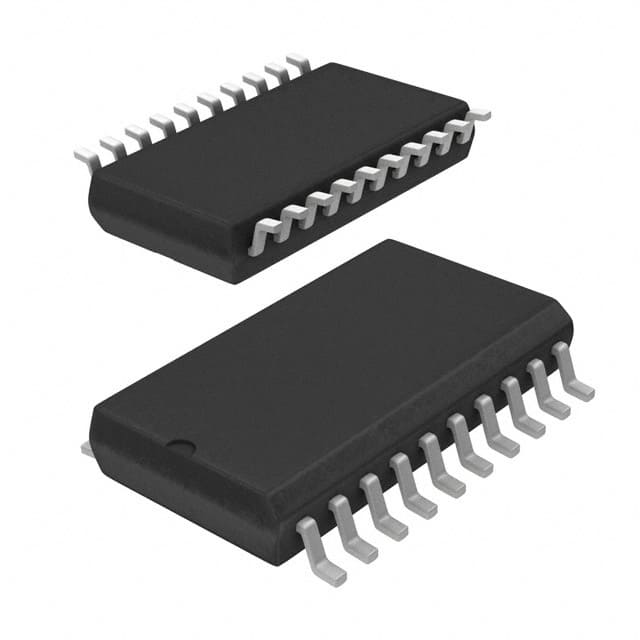Lihat spesifikasi untuk detail produk.

74LVTH2245D,118
Basic Information Overview
- Category: Integrated Circuit (IC)
- Use: Level Shifter and Bus Transceiver
- Characteristics: High-speed, low-power, bidirectional voltage level translation
- Package: SOIC (Small Outline Integrated Circuit)
- Essence: Translates signals between different voltage levels in digital systems
- Packaging/Quantity: Tape and Reel, 2500 pieces per reel
Specifications
- Supply Voltage Range: 1.65V to 5.5V
- Logic Family: LVTH (Low-Voltage TTL with 3-state outputs)
- Number of Channels: 8
- Input/Output Compatibility: 5V CMOS, 3.3V CMOS, and 2.5V CMOS
- Maximum Data Rate: 400 Mbps
- Output Drive Capability: ±24 mA
- Operating Temperature Range: -40°C to +85°C
Detailed Pin Configuration
The 74LVTH2245D,118 IC has a total of 20 pins arranged as follows:
___________
OE1 -| 1 20 |- VCC
A1 -| 2 19 |- B1
A2 -| 3 18 |- B2
A3 -| 4 17 |- B3
A4 -| 5 16 |- B4
A5 -| 6 15 |- B5
A6 -| 7 14 |- B6
A7 -| 8 13 |- B7
GND -| 9 12 |- B8
OE2 -| 10 11 |- A8
¯¯¯¯¯¯¯¯¯
Functional Features
- Bidirectional voltage level translation between different logic families
- 3-state outputs allow multiple devices to share a common bus
- High-speed operation with low propagation delay
- Low power consumption
- ESD protection on all inputs and outputs
Advantages and Disadvantages
Advantages: - Wide supply voltage range allows compatibility with various systems - High-speed operation enables efficient data transfer - 3-state outputs facilitate bus sharing among multiple devices - ESD protection ensures robustness against electrostatic discharge
Disadvantages: - Limited number of channels (8 in this case) - May require additional external components for certain applications
Working Principles
The 74LVTH2245D,118 is designed to translate signals between different voltage levels in digital systems. It utilizes a combination of CMOS technology and TTL-compatible inputs/outputs to achieve bidirectional level shifting. The device operates by monitoring the input voltage levels and translating them to the desired output voltage levels based on the logic family compatibility.
Detailed Application Field Plans
The 74LVTH2245D,118 IC finds applications in various fields where voltage level translation is required. Some common application areas include: - Interfacing between different logic families (e.g., 5V and 3.3V) - Communication systems involving mixed-voltage devices - Microcontroller and FPGA interfacing - Industrial automation and control systems - Consumer electronics
Detailed and Complete Alternative Models
Some alternative models that offer similar functionality to the 74LVTH2245D,118 IC are: - SN74LVC245A: Octal Bus Transceiver with 3-state Outputs - NC7WZ125: Dual Buffer/Line Driver with 3-state Outputs - TXB0108: 8-Bit Bidirectional Voltage-Level Translator
These alternatives can be considered based on specific requirements and compatibility with the target system.
Word count: 346 words
Sebutkan 10 pertanyaan dan jawaban umum terkait penerapan 74LVTH2245D,118 dalam solusi teknis
Sure! Here are 10 common questions and answers related to the application of 74LVTH2245D,118 in technical solutions:
Q: What is the 74LVTH2245D,118? A: The 74LVTH2245D,118 is a bidirectional octal bus transceiver with 3-state outputs. It can be used for level shifting and signal buffering in digital systems.
Q: What is the operating voltage range of the 74LVTH2245D,118? A: The operating voltage range is typically between 1.65V and 5.5V.
Q: How many channels does the 74LVTH2245D,118 have? A: The 74LVTH2245D,118 has 8 bidirectional channels.
Q: Can the 74LVTH2245D,118 handle high-speed data transmission? A: Yes, it is designed to operate at high speeds and can support data rates up to 400 Mbps.
Q: Does the 74LVTH2245D,118 have built-in protection features? A: Yes, it has integrated ESD (electrostatic discharge) protection on all inputs and outputs.
Q: Can I use the 74LVTH2245D,118 for level shifting between different voltage domains? A: Yes, it can be used for level shifting between different voltage levels, making it suitable for interfacing between different logic families.
Q: What is the maximum output current of the 74LVTH2245D,118? A: The maximum output current is typically around 12mA.
Q: Can I connect multiple 74LVTH2245D,118 devices together to expand the number of channels? A: Yes, multiple devices can be connected together to increase the number of bidirectional channels.
Q: Does the 74LVTH2245D,118 have any power-saving features? A: Yes, it has a low-power standby mode that can be activated to reduce power consumption when the device is not in use.
Q: What is the package type of the 74LVTH2245D,118? A: The 74LVTH2245D,118 is available in various package types, such as SOIC (Small Outline Integrated Circuit) and TSSOP (Thin Shrink Small Outline Package).
Please note that the answers provided here are general and may vary depending on the specific datasheet and manufacturer's specifications for the 74LVTH2245D,118.

